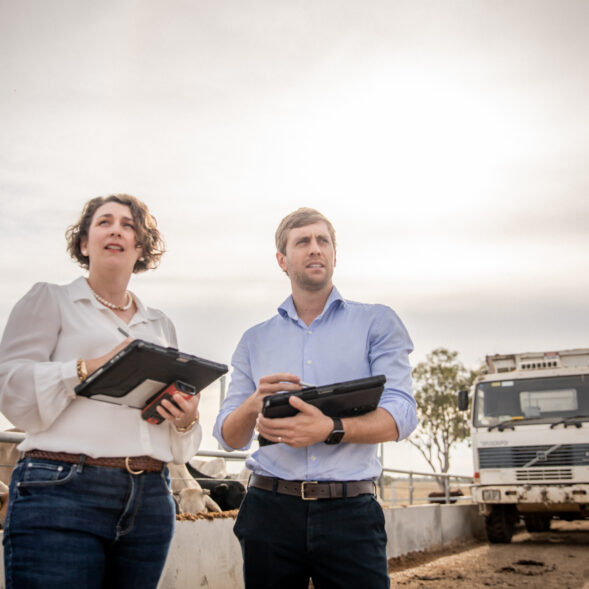National Overview from our Agribusiness Experts
Vic/Tas
There is a fairly universal view among agents and farmers that the market for cropping land across most Victorian regions has now plateaued following a significant increase in the years from 2020 to 2023. Values for better cropping land are now roughly double, and in some cases have tripled, from what they were –eight to ten years ago, driven by a desire to gain greater economies of scale and helped by a run of above average seasons.
Well below average autumn rainfall throughout much of the state resulted in patchy germination and a reduced crop forecast. The Mallee region is in better shape than most, however the Wimmera and north and central cropping regions are behind schedule, with many crops sown dry, and then receiving only light rainfall leading into winter. Winter crop production is currently forecast to be 9.2 million tonnes, down 13 per cent on the 2023 season.
Generally in dry seasons we see a more cautious approach from farmers, who elect to preserve their cash, given the high cost of inputs. This tends to put any expansion plans on hold.
The reduced sentiment has been reflected in fewer property sales during the first half of 2024. In some cases, such as the well improved Pendrea at Werrimull (50 kilometres west of Mildura) which went to auction in March, buyers weren’t willing to match the vendor’s expectations and the property was passed in.
The purchase by Gofarm in April 2024 of the 2,336 hectare Eurambeen Station near Beaufort and the nearby 979 hectare Grandview is an indication that there is continued corporate interest in buying productive cropping country in safe rainfall areas. The scale of these properties and presence of relatively uniform soil types would likely have proved the main attractions.
It is also clear that agents and vendors have delayed marketing of cropping properties until the spring, in the hope that seasonal conditions will improve. The recent firming of some key commodities (particularly lamb and beef), grain and pulse prices remaining relatively stable, and the recent Bureau of Meteorology forecast of above average rainfall across south-east Australia for the second half of 2024 may result in a more active market moving forward.
Graeme Whyte
Northern NSW
There has been a significant increase in winter crop plantings across the growing areas of New South Wales on the back of good soil moisture profiles. Some marginal (lower rainfall) areas have been able to plant crops which has led to the forecast that this year’s crop is set to increase to approximately 15 million tonnes, an increase of approximately 28 per cent from the 2023/24 growing season.
The forecast is that approx. 6.1 million hectares will be planted to winter crops in New South Wales which is dominated by wheat (3.6 million hectares), barley (870,000 hectares), canola (830,000 hectares) and chickpeas (310,000 hectares).
Prices for wheat and barley have remained relatively steady in New South Wales with wheat ranging from $335 to $365 per tonne, barley ranging from $310 to $360 per tonne and sorghum ranging from $310 to $355 per tonne. Barley prices are stable with an anticipated tightening in supply while wheat and sorghum prices are fluctuating across the state.
July winter rainfall, post planting, through large parts of central and western New South Wales is likely to benefit the planted crops and it is anticipated that winter crop yields will increase to forecast levels of 2.7 tonnes per hectare for wheat, 2.8 tonnes per hectare for barley, 1.9 tonnes per hectare for canola and 1.7 tonnes per hectare for chickpeas.
Angus Ross
Southern NSW
The mixed farming and grazing market in south-eastern New South Wales for Quarter 4, 2024 remains stagnant after a period of softening in 2023. The southern sections have had a dryer than average autumn extending into winter with many graziers in the Upper Murray and eastern Riverina either feeding stock or destocking to more conservative levels. Two recent properties marketed for sale resulted in vendor bids only. The May to June marketing campaign of Glensloy, a 1,082 hectare third generation mixed farming holding situated in the typically tightly held locality of Young, passed in at a vendor bid reflecting an overall rate in the order of $15,000 per hectare.
Agents handling the sale reported strong interest in the holding from surrounding neighbours including a number of large, well established farming families, however no bids were tendered at auction. In the highly sought after Upper Murray, the June to July marketing campaign of Gwendoline and Sandy Creek, also resulted in the properties being passed in. The combined holding comprises a 305 hectare mixed farming operation in the blue-ribbon location of Tooma. The selling agent reports that discussions with a potential purchaser have continued at levels of between $23,500 and $25,000 per hectare. From market transactions occurring in both regions in late 2022 and early 2023, this market evidence would suggest the market has softened potentially in the order of 10 per cent.
Brett Parbery
NSW Riverina and Northern Victoria
Seasonally, the central and western parts of the Riverina (Narrandera through to Hay and Hillston), have received good late autumn rain and the winter crops are well established and looking good. The dry autumn helped cotton growers with a long finish to crops and many have obtained good yields well north of 14 bales per hectare. Areas further east, particularly south of Wagga through to northern Victoria, have not been as fortunate with rainfall. Many crops were late planted and have been progressing slowly with regular lighter falls. Many operators will be hoping for a shift in weather patterns moving into the critical early spring phase.
Market activity generally in the smaller to medium scale cropping segment of the market appears to have slowed with fewer listings on the market and a noticeable decrease in the number of potential buyers competing for properties currently offered for sale. Agents are pointing to interest rates and corresponding borrowing costs as the main factors driving a softening in demand. Many farm owners expanded in the past few years and values nearly doubled in some areas. The majority of that growth was debt funded.
Counter to this trend for smaller holdings, corporate and investor interest in the large scale end of the cropping property market remains solid with some large transactions occurring in the first half of 2024. A recent example is the reported sale of the Commins Portfolio, a group of 10 properties totalling 2,807 hectares located at Whitton and Darlington Point in the central Riverina. The sale included over 14,000 megalitres of ground and surface water entitlements. Over 80 per cent of the total holdings are developed to modern bankless flood irrigation with a significant level of supporting working improvements. The reported sale price of over $88 million indicates a rate per hectare for the irrigated land excluding water of well over $12,000 per hectare. This represents a premium on recent market sales rates and highlights the demand for large scale turnkey holdings in this locality, particularly with multiple sources of irrigation entitlements.
Andrew Garnsey








